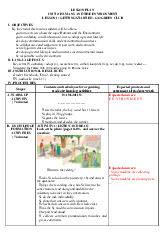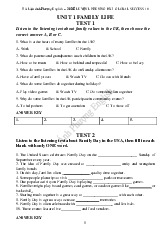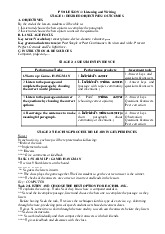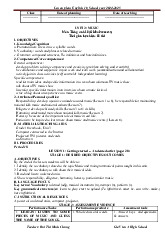












Preview text:
REVIEW 4 (Unit 9+10) Lesson 1: Language I. Objectives
By the end of this lesson, students will be able to: 1. Knowledge
- Review using words related to protecting the environment and ecotourism;
- Review how to pronounce the sentences with suitable rhythm and intonation;
- Apply the knowledge of grammar points learnt in the previous units (reported speech and conditional sentences type 1 and 2) to do the tasks. 2. Core competence
- Develop communication skills and cultural awareness;
- Be collaborative and supportive in pair work and teamwork;
- Actively join in class activities. 3. Personal qualities - Develop self-study skills;
- Raise students’ awareness of the need to protect the environment. II. Materials
- Grade 10 textbook, Review 4 – Language
- Computer connected to the internet
- Projector/ TV/ pictures and cards - sachmem.vn Assumptions
Anticipated difficulties Solutions
- Encourage students to work in pairs, in groups so that they can
1. Students may find the lesson boring due help each other.
to a large number of language exercises.
- Design as many exercises as games as possible.
- Provide feedback and help if necessary.
- Define expectation in explicit detail.
2. Some students will excessively talk in the
- Have excessive talking students practise. class.
- Continue to define expectations in small chunks (before every activity). Board Plan Date of teaching REVIEW 4 Lesson 1: Language * Warm-up Video watching Pronunciation
Mark the stressed syllables in the words in bold. Vocabulary
Task 1: Complete the following sentences.
Task 2: Choose the correct word or phrase. Grammar
Task 1: Change these sentences into reported speech.
Task 2: Match the two parts to make complete sentences. * Homework III. Procedures Notes:
In each activity, each step will be represented as following * Deliver the task ** Implement the task *** Discuss
**** Give comments or feedback Stage Stage aim Procedure Interaction Time WARM-UP To lead in the GAME: VIDEO WATCHING 5 mins lesson.
* T plays the video of ecotourism. T-S
** Ss watch the video and write down the main ideas. S
*** T and Ss discuss the contents of the video. T-S
**** T confirms the answers and leads in the lesson. T-S
Link: https://www.youtube.com/watch?v=1i4ioqIaXrE
PRONUNCIATION To help Ss review MARK THE STRESSED SYLLABLES IN THE WORDS IN BOLD. LISTEN 5 mins sentence stress
AND REPEAT, PAYING ATTENTION TO THE RHYTHM. (p. 120) and practise
* T asks Ss to read the sentences and mark the stressed syllables in T-S speaking with a the words in bold. natural rhythm.
** Ss listen to the recording and check the answers. S
*** T plays the recording again, pausing after each sentence for Ss to T-S
repeat as naturally as possible.
**** T checks students’ pronunciation and gives feedback. T-S Key:
1. I 'like 'trekking in the 'mountains.
2. The 'children are 'looking 'forward to the 'boat 'trip.
3. Are you going to 'visit the mu'seum to'morrow?
4. 'Don’t 'litter while you are on the 'ecotour. VOCABULARY
To help Ss review TASK 1: COMPLETE THE FOLLOWING SENTENCES USING THE 5 mins
phrases related to PHRASES FROM THE BOX. (p. 120)
environment and * T tells Ss to read the sentences carefully and makes sure they T-S tourism. understand their meanings.
** Ss do this exercise individually. S
*** T allows Ss to share their answers before discussing as a class and Pair work
encourages them to pronounce the sentences correctly.
**** T checks the answers as a class and gives feedback. T-S Key: 1. c 2. e 3. b 4. d 5. a
To help Ss further TASK 2: CHOOSE THE CORRECT WORD OR PHRASE TO COMPLETE 7 mins practice the use
EACH OF THE FOLLOWING SENTENCES. (p. 120) of the words
* T asks Ss to work in pairs to complete the sentences with the given T-S related to words and phrases.
environment and ** Ss work in pairs to complete the task. S tourism.
*** T allows Ss to share answers before discussing as a class. Pair work
**** T asks Ss to say the sentences aloud and makes sure they T-S
pronounce the words and phrases correctly. T can ask for translation to check their understanding. Key: 1. ecosystem 2. eco-friendly 3. litter 4. Ecotourism 5. biodiversity GRAMMAR
To help Ss review TASK 1: CHANGE THESE SENTENCES INTO REPORTED SPEECH. (p. 121) 10 mins the use of
* T elicits when we use reported speech and what changes we make T-S reported speech.
when we convert direct speech to reported and asks Ss to do the activity individually.
** Ss do the task individually. S
*** T allows Ss to share answers before discussing as a class. T-S
**** T can ask Ss to read aloud the full sentences and correct their T-S pronunciation if needed. Key:
1. My brother said he was doing research into sustainable tourism.
2. Minh asked Nam if / whether he liked watching programmes about wildlife and nature.
3. Hoa asked Mr Smith what they could / can do to reduce the impact
of global warming on the environment.
4. The club’s secretary said they were going to organise a lot of
activities during Earth Hour that year.
5. The teacher explained that the animals would / will not survive
extreme cold weather in the North.
To help Ss review TASK 2: MATCH THE TWO PARTS TO MAKE COMPLETE SENTENCES. 8 mins conditional (p. 121)
sentences Types 1 * T elicits the structure and use of conditional sentences Types 1 and 2 T-S and 2. and asks Ss to do the task.
** Ss do the task individually. S
*** T asks Ss to compare their answers in pairs. S-S
**** T can ask Ss to read aloud the full sentences and correct their T-S pronunciation if needed. Key: 1. d 2. a 3. c 4. e 5. b HOMEWORK - To consolidate WRAP-UP T-S 5 mins what students
T asks Ss to talk about what they have learnt in the lesson.
have learnt in the HOMEWORK lesson.
- Do exercise in the workbook. - To prepare
- Prepare for Review 4 – Skills: Listening and Speaking. vocabulary for the next lesson. REVIEW 4 (Unit 9 + 10)
Lesson 2: Skills – Listening and Speaking I. OBJECTIVES
By the end of this lesson, Ss will be able to: 1. Knowledge
- Practice listening for general and specific information about a day trip;
- Practice talking about the plan of a day trip. 2. Core competence
- Develop communication skills and cultural awareness;
- De collaborative and supportive in pair work and teamwork;
- Actively join in class activities. 3. Personal qualities - Develop self-study skills;
- Raise students’ awareness of the need to protect the environment. II. MATERIALS
- Grade 10 textbook, Review 4 – Skills: Listening and Speaking
- Computer connected to the internet
- Projector/ TV/ pictures and cards - sachmem.vn Assumptions
Anticipated difficulties Solutions
- Encourage students to work in pairs, in groups so that they
1. Students may find the lesson boring can help each other.
due to a large number of language
- Design as many exercises as games as possible. exercises.
- Provide feedback and help if necessary.
2. Some students will excessively talk in
- Define expectation in explicit detail. the class.
- Have excessive talking students practise.
- Continue to define expectations in small chunks (before every activity). Board Plan Date of teaching REVIEW 4 Lesson 2: Skills * Warm-up
Video watching: Travel plans Listening
Task 1: Choose the best title for the talk. Task 2: Complete the notes. Speaking
Discuss and plan your imaginary day trip. * Homework III. PROCEDURES Notes:
In each activity, each step will be represented as following * Deliver the task ** Implement the task *** Discuss
**** Give comments or feedback Stage Stage aim Procedure Interaction Time
WARM-UP To lead in the lesson.
VIDEO WATCHING: TRAVEL PLANS 5 mins
* T plays the video of travel plans. T-S
** Ss watch the video and write down the main ideas. S
*** T and Ss discuss the contents of the video. T-S
**** T confirms the answers and leads in the lesson. T-S
Link: https://www.youtube.com/watch?v=ePtKgkMVtOc LISTENING To help Ss practise
TASK 1: LISTEN AND CHOOSE THE BEST TITLE FOR THE TALK. (p. 122) 7 mins listening for gist.
* T has Ss read the three options for the title of the talk. T-S
** Ss look at three options, read and underline key words. S
*** T plays the recording once for Ss to listen and choose the best T-S answer.
**** T confirms the answers as a class. T-S Key: A To help Ss practise
TASK 2: LISTEN AGAIN AND COMPLETE THE NOTES WITH NO MORE 13 mins listening for specific
THAN TWO WORDS. (p. 122) information and
* T asks Ss to look at the notes, underline the key words and decide T-S keywords.
what kind of information they need to fill in each blank, e.g. 1:
number; 2: noun (phrase); 3: noun (phrase); 4: noun (phrase); 5: noun (phrase).
** Ss listen and do the task individually. Individual
*** T calls on some students to report their answers for the class. work
**** T checks the answers and adds more information if necessary. T-S Key: 1. 8 2. house 3. local family 4. pagoda 5. litter SPEAKING To help Ss practise
IMAGINE THAT YOU ARE GOING ON A DAY TRIP. WORK IN PAIRS. 15 mins
discussing and planning DISCUSS AND PLAN YOUR TRIP. USE THE FOLLOWING POINTS TO about a day trip. HELP YOU. (p. 122)
* T asks Ss to read through the suggestions and take notes of the T-S ideas.
** Ss work in pairs to exchange their ideas about their day trip plan. Pair work
*** T calls on some students to report their answers for the class.
**** T checks the answers and adds more information if necessary. T-S HOMEWOR - To consolidate what WRAP-UP T-S 5 mins K
students have learnt in Teacher asks students to talk about what they have learnt in the the lesson. lesson. - To prepare HOMEWORK
vocabulary for the next - Do exercise in the workbook. lesson.
- Prepare for Review 1 – Skills: Reading and Writing. REVIEW 4 (Unit 9+10)
Lesson 2: Skills 2 – Reading and Writing I. OBJECTIVES
By the end of this lesson, Ss will be able to: 1. Knowledge
- Practice reading for general and specific information about how to protect the environment;
- Practice writing a short paragraph about things they should or shouldn’t do to reduce the negative impact of travelling on the environment. 2. Core competence
- Develop communication skills and cultural awareness;
- Be collaborative and supportive in pair work and teamwork;
- Actively join in class activities. 3. Personal qualities - Develop self-study skills;
- Raise students’ awareness of the need to protect the environment. II. MATERIALS
- Grade 10 textbook, Review 4 – Skills: Reading and Writing
- Computer connected to the internet
- Projector/ TV/ pictures and cards - sachmem.vn Assumptions
Anticipated difficulties Solutions
- Encourage students to work in pairs, in groups so that they
1. Students may find the lesson boring due can help each other.
to a large number of language exercises.
- Design as many exercises as games as possible.
- Provide feedback and help if necessary.
- Define expectation in explicit detail.
2. Some students will excessively talk in the - Have excessive talking students practise. class.
- Continue to define expectations in small chunks (before every activity). Board Plan Date of teaching REVIEW 4 Lesson 2: Skills * Check-up
Talk about your plan for a day trip Reading
Task 1: Match the highlighted words in the text with their meanings.
Task 2: Choose the best answers. Writing
Write about things you should or shouldn’t do to reduce the negative impact of travelling on the environment. * Homework III. PROCEDURES Notes:
In each activity, each step will be represented as following * Deliver the task ** Implement the task *** Discuss
**** Give comments or feedback Stage Stage aim Procedure Interaction Time CHECK-UP To check the
TALK ABOUT YOUR PLAN FOR A DAY TRIP 5 mins knowledge in the
* T elicits the requirement of talking about your plan for a day trip. T-S previous lesson and ** Ss raise hands to answer. S give students more
*** T listens to student‘s answers and takes notes for comments. T-S chance to practice
**** T provides comments and feedback. T-S speaking. READING To help Ss practise
TASK 1: READ THE TEXT. MATCH THE HIGHLIGHTED WORDS IN THE 10 mins understanding word
TEXT WITH THEIR MEANINGS. (p.123) meanings from
* T asks Ss to read the whole text once to get an overall idea. T-S context.
** Ss read the text again, paying attention to the context of each S
highlighted word, then look at the three definitions.
*** T tells Ss to work in groups to discuss the context clue for each word T-S and compare answers.
**** T confirms the answers as a class. T-S Key: 1. b 2. a 3. c To help Ss practise
TASK 2: READ THE TEXT AGAIN AND CHOOSE THE BEST ANSWERS. 10 mins reading for main ideas (p.123) and specific
* T asks Ss to read through the questions and checks understanding of T-S information. the vocabulary.
** Ss read the text again and look for the answers to the questions. Individual
*** T calls on some students to report their answers for the class. work
**** T checks the answers and adds more information if necessary. T-S Key: 1. A 2. B 3. C WRITING To help Ss practise
WRITE A PARAGRAPH (120 - 150 WORDS) ABOUT THINGS YOU 15 mins writing a paragraph
SHOULD OR SHOULDN’T DO TO REDUCE THE NEGATIVE IMPACT OF about things they
TRAVELLING ON THE ENVIRONMENT. YOU MAY USE THE IDEAS IN should or shouldn’t do
THE READING TO HELP YOU. (p. 123) to reduce the negative T-S impact of travelling on
* T asks Ss to read the text again and extract some ideas for their the environment.
writing, e.g. walk, cycle or use public transport. Pair work
** Ss complete the task individually and write a paragraph (120 – 150
words), then swap their paragraphs for peer review with a partner.
*** T gives Ss enough time to complete the paragraph. T sets a time
limit depending on the Ss’ ability level. T-S
**** T asks individual Ss to read their paragraphs or collects them to
check after class and provides written feedback. Sample answer:
There are several things that we should do to reduce the negative
impact of travelling on the environment. Firstly, we should reduce our
carbon footprint during the trip. We should only fly when the trip is
long and choose environmentally-friendly means of transport such as
cycling or public transport. Secondly, wherever we go, we should
always protect our environment. By keeping it clean and safe, we can
reduce the negative impact of travelling on the environment. HOMEWOR - To consolidate what WRAP-UP T-S 5 mins K
students have learnt in Teacher asks students to talk about what they have learnt in the the lesson. lesson. - To further practice HOMEWORK writing
- Do exercise in the workbook.
- Write the final draft for the paragraph about things they should or
shouldn’t do to reduce the negative impact of travelling on the environment.




